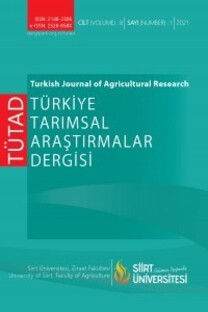Molehiya (Corchorus olitorius L.) Tohumlarındaki Dormansi Probleminin Çözümüne Yönelik Araştırma
Bu araştırmada; lif bitkisi ve tıbbi bitki olarak kullanımının yanı sıra, sebze olarak da tüketim değeri olan molehiya (Corchorus olitorius L.) bitkisinin tohumlarında, dormansiyi kırmak için farklı tohum uygulamalarının çimlenme ve çıkış üzerine etkisi amaçlanmıştır. Bu amaçla sterilizasyonu yapılan tohumlara; kaynayan su (95 ºC; 10 ve 30 saniye, 1, 5 ve 10 dakika), sıcak su (80 ºC; 5, 10, 15 ve 20 dakika), sülfürik asit (% 98’lik; 5, 10, 15, 20, 25 ve 30 dakika) ve ön soğutma uygulamaları (4ºC; 2, 3 ve 4 gün) yapılmıştır. Denemeler; laboratuvar ortamında, 4 tekerrürlü ve her tekerrürde 50 tohum olacak şekilde tesadüf parselleri deneme desenine göre yürütülmüştür. Elde edilen sonuçlara göre; çimlenme oranı % 0.00-97.00, ortalama çimlenme süresi 0.00-3.98 gün, çimlenme indeksi 0.00-46.89, çıkış oranı % 0.00-82.00, ortalama çıkış süresi 0.00-7.52 gün, çıkış indeksi 0.00-18.70, hipokotil boyu 0.00-1.79 cm ve kökçük boyu ise 0.00-4.28 cm arasında değişim göstermiştir. Çimlenme ve çıkış parametreleri bakımından en başarılı uygulamalar; ön soğutma, sülfürik asit (5 ve 10 dakika) ve kaynayan su (95 ºC, 10 saniye) uygulamaları olmuştur. Çalışma sonucunda, Corchorus olitorius L. tohumlarında dormansiyi ortadan kaldırmada, ekimden önce tohumların 2 gün süreyle nemli ortamda soğukta (4 ºC) bekletilmesinin pratikte de rahatlıkla uygulanabileceği sonucuna ulaşılmıştır.
Anahtar Kelimeler:
Corchorus olitorius L., tohum, çimlenme, hipokotil, kökçük
Research on Overcoming the Dormancy Problem of Molekhia (Corchorus olitorius L.) Seeds
In this study, the effect of different seed applications on germination and emergence in order to break dormancy of the seeds of molekhia (Corchorus olitorius L.) which is used as fiber, medicinal plant and consumed as a vegetable, was investigated. For this purpose, sterilized seeds were exposed to boiling water (95 ºC; 10 and 30 seconds, 1, 5 and 10 minutes), hot water (80 ºC; 5, 10, 15 and 20 minutes), sulfuric acid (98%; 5, 10, 15, 20, 25 and 30 minutes) and pre-cooling (4 ºC; 2, 3 and 4 days) treatments. The experiments were carried out according to randomized blocks trial design with 4 replications and 50 seeds per replicate. According to results obtained, germination rate 0.00-97.00%, average germination time 0.00-3.98 days, germination index 0.00-46.89, emergence rate 0.00-82.00%, average emergence time 0.00-7.52 days, emergence index 0.00-18.70, hypocotyl length 0.00-1.79 cm and radicle length values varied between 0.00 and 4.28 cm. The most successful treatments in terms of germination and emergence parameters were pre-chilling, sulfuric acid (for 5 and 10 minutes) and boiled water (at 95 ºC for 10 seconds) applications. As a result of the study, in order to remove the dormancy from the Corchorus olitorius L. seeds, treatment of the seeds with pre-cooling (4 ºC for 2 days) in a humid environment before sowing would be easily practiced.
Keywords:
Corchorus olitorius L., seed, germination, hypocotyl, radicle,
___
- Anonim, 2017. Sebze olarak değerlendirilen yeşillikler “Molehiya”. http://www.dunyagida.com.tr/haber/ sebze-olarak- degerlendirilen-yesilliklermolehiya/ 3542 (Erişim tarihi: 12.06.2017).
- Bharucha, Z., Pretty, J., 2010. The roles and values of wild foods in agricultural systems. Philosophical Transactions of the Royal Society, 365(1554): 2913-2926.
- Emongor, V.E., Mathowa, T., Kabelo, S., 2004. The effect of hot water, sulphuric acid, nitric acid, gibberellic acid and ethephon on the germination of Corchorus (Corchorus tridens) seed. Journal of Agronomy, 3(3): 196-200.
- İslam, M., 2013. Biochemistry, medicinal and food values of Jute (Corchorus capsularis L. and C. olitorius L.) leaf: A Review. International Journal of Enhanced Research in Science Technology & Engineering, 2(11): 35-44.
- Lewu, F.B., Mavengahama, S., 2010. Wild vegetables in Northern KwaZulu Natal, South Africa: Current status of production and research needs. Scientific Research and Essays, 5(20): 3044-3048.
- Li, C., Feng, S., Shao, Y., Jiang, L., Lu, X., Hou, X., 2007. Effects of arsenic on seed germination and physiological activities of wheat seedlings. Journal of Environmental Sciences, 19(6): 725-732.
- Mavengahama, S., Lewu, F.B., 2012. Comparative evaluation of the germination capability of three morphologically different wild genotypes of Corchorus olitorius L. from Northern KwaZulu-Natal, South Africa. African Journal of Biotechnology, 11(22): 6050-6054.
- Mercedes, F., Carbonell, M.V., Martinez, E., 2007. Exposure of maize seeds to stationary magnetic fields: Effects on germination and early growth. Environmental and Experimental Botany, 59(1): 68-75.
- Ndlovu, J., Afolayan, A.J., 2008. Nutritional analysis of the South African wild vegetable Corchorus olitorius L. Asian Journal of Plant Sciences, 7(6): 615-618.
- Nkoma, M., Kambizi, L., 2009. Effects of pre-chilling and temperature on seed germination of Corchorus olitorius L. (Tiliaceae) (Jew’s Mallow), a wild leafy vegetable. African Journal of Biotechnology, 8(6): 1078-1081.
- Ologundudu, A.F., Adelusi, A.A., Adekoya, K.P., 2013. Effect of light stress on germination and growth parameters of Corchorus olitorius, Celosia argentea, Amaranthus cruentus, Abelmoschus esculentus and Delonix regia. Notulae Scientia Biologicae, 5(4): 468-475.
- Velempini, P., Riddoch, I., Batısani, N., 2003. Seed treatments for enhancing germination of wild okra (Corchorus olitorius). Experimental Agriculture, 39(4): 441-447.
- Yıldırım, E., Güvenç, İ., 2006. Salt tolerance of pepper cultivars during germination and seedling growth. Turkish Journal of Agriculture and Forestry, 30(5): 347-353.
- ISSN: 2148-2306
- Başlangıç: 2014
- Yayıncı: SİİRT ÜNİVERSİTESİ ZİRAAT FAKÜLTESİ
Sayıdaki Diğer Makaleler
Abdurrahman YILDIZ, Mehmet Arif ÖZYAZICI
Seçilmiş Bazı Yabani Erik Anaç Adaylarının Kayısılarda Bazı Makro Besin Maddeleri Alımına Etkileri
Remzi UĞUR, Sevgi PAYDAŞ KARGI
Sarıgöl Ovası Yer Altı Su Kaynaklarının Sulama Amaçlı Kalitesinin Değerlendirilmesi
Siirt İli Küçükbaş Hayvan İşletmelerinde Barınakların Mevcut Durumu
Galip BAKIR, Nazire MİKAİL, Serkan BAYGELDİ
Research on Overcoming the Dormancy Problem of Molekhia (Corchorus olitorius L.) Seeds
Ferda ARI, Egemen DERE, Hakan TOSUNOĞLU, İmren ALİOĞLU
Tarımsal Biyoteknolojide Mobil Genetik Elementlerin Moleküler Markör Olarak Kullanılması
